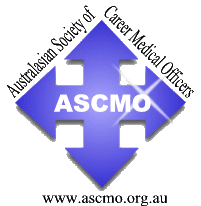
Australasian Society of
Career Medical Officers
www.
ascmo.org.au
ASCMO Education index
updated April 2016
Whats New ?
Members only
Industrial info
Education
CPDP
Jobs for CMOs
Links
CMO Bulletin
Contact us
Join us
Next Meeting
Open Forum
Disclaimer
Welcome to
ASCMO EDUCATION
incorporating the Continuing Professional Development Program (CPDP)
![]() The 'CMO club' is a new concept in CMO continuing medical education for experienced practitioners. Provides a series of educational modules and model answers to run educational discussion sessions
amongst your peers.
Full details available at CMO - Club
The 'CMO club' is a new concept in CMO continuing medical education for experienced practitioners. Provides a series of educational modules and model answers to run educational discussion sessions
amongst your peers.
Full details available at CMO - Club
This page is for the use of CMOs (and others)
to encourage educational input and discussion. It is hoped that
this site will be a living, growing resource. All input
gratefully received and considered.
| Please direct all correspondence
to Gabrielle duPreez-Wilkinson, ASCMO Education Officer or tell us what you want through our ASCMO "Education / CPDP" Feedback Form |
|
| phone: 0408 980 825 Mob 07 3212 5721 Home |
via email: |
CONTENTS
"CMO Club" - Educational modules for experienced CMOs Current Topics .. The "Hospitalist Debate" Masters Degree in Clinical Medicine suitable for all CMOs |
EDUCATION NEWS
![]() Continuing professional development program (CPDP)
:
Continuing professional development program (CPDP)
:
at last a Continuing Medical Education Program suitable for ALL CMOs
The Electronic Log Book (produced by the Continuing Professional Development Program - CDPD - of the Royal College of Pathologists of Austalasia) is available to members of ASCMO. This is excellent CME and all members are encouraged to utilize it. The cost is $55-00 which is very reasonable. All CMOs on our mailing list have received an application form.
![]() Click here for Full information about CPDP
Click here for Full information about CPDP
NB: Please note that this Programme is ONLY available to CMOs who are financial
members of ASCMO. If you are not a current member, you
can re-new your membership, or join ASCMO, using our on-line ASCMO Application
form
![]() ASCMO
has been trying to develop a Masters Degree Course suitable for CMOs
ASCMO
has been trying to develop a Masters Degree Course suitable for CMOs
ASCMO has worked with the University of Queensland and Newcastle developing a Masters degree in Clinical Medicine. Your input continues to be valuable. Visit our "Masters" page for further details.
CURRENT TOPICS
The Hospitalist Debate
Those of you who have been keeping up with CMO issues, and reading the Medical Journal of Australia, may have realised that we are involved in the debate on the use of "hospitalists" in the Australian setting. Basically a hospitalist is a doctor whose main area of expertise is the management of the inpatient. No such position formally exists at present, but articles by Hillman (Med J Aust 1999; 170: 325-328) and Scott and Phillips (Med J Aust 1999; 171: 312-314) have suggested intensivists or physicians as future hospitalists - We believe that career medical officers have, in many cases, been performing this role and are, anyway, well equipped to perform in such a practice and should be involved in any discussion on this career.
In order to put this position before current debate, the ASCMO committee members co-authored an article "The Hospitalist: a third alternative" which was published in the 3rd April 2000 issue of the MJA ("The Hospitalist: a third alternative": John M Egan et al. MJA 2000; 172: 335-338)
CURRENT ARTICLES of INTEREST
"The Hospitalist: a third alternative": John M Egan et al. MJA 2000; 172: 335-338
CORRESPONDENCE
-
This site to communicate ideas on
education
.. Post-Graduate Year 3 And Beyond by John Egan
PRACTICE TIPS (see Disclaimer below)
1. Use of Sodium Bicarbonate to lessen pain of lignocaine local anaesthetic
Although I had been aware of this for some time, it was only when the local Ophthalmologist was anaesthetising my upper eyelid to "needle" a meibomian cyst that I appreciated how much the addition of a buffer decreases the discomfort of infiltration.
He used sodium bicarbonate (readily available in 5ml amps) and drew up enough to fill the mouth of a 1ml syringe and then drew up the lignocaine. Along with the use of a 27 gauge needle it made the procedure (that I was not really looking forward to) almost painless. I now use buffered lignocaine with nearly all childhood lacerations etc.
A recent article in the American Journal of Emergency Medicine (vol 16 no 4 July1998) shows in a double blind study further benefit by warming the solution to body temperature. Buffered lignocaine is definitely an improvement on unbuffered lignocaine but combining this with warming adds significantly to the effect. The authors suggest a 9 to 1 ratio (lignocaine to sod bicarbonate) prepared no more than four hours before use.
John Egan. (November 1998)
2. Management of severe migraine
Always difficult, however one therapy found to be effective is the following:
IVI Chlorpromazine.
The use of this treatment presupposes that you have excluded a serious cause for the headache - particularly SAH, meningitis, trauma etc by adequate history and physical examination. The therapy is particularly useful for those patients who have been treated for migraine by narcotics in the past and have become dependant.
Dose 12.5mg Chlorpromazine (half ml of 50mg, 2ml amp) IVI. Given over 10-20 mins (in burette of normal saline or Hartmanns Soln) usually followed by the rest of the litre of solution over approx.1hr in adults. Useful if vomiting a major feature. Can be combined with metoclopramide 10mg. Repeated once if necessary (rarely necessary). Check BP before, during and after treatment, hypotension a possibility (rarely a problem). Most patients drowsy but quite happy and able to go home and go to sleep. Obviously should not drive that day and should be in care of responsible adult.

